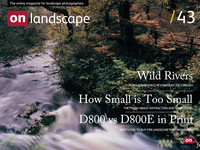
The Diffraction Limit
I think most photographers will have come across various online resources, books, magazines and blog posts telling them that certain apertures are 'out of bounds' and that in order to get the sharpest pictures they need to use a narrow band of apertures (usually f/5.6 or f/8 for 35mm cameras). As mentioned in last issue though, a test of some lenses seen recently where smaller aperture results on the D800 resolved more than the best aperture results on a more

Diffraction Limited?
I was browsing through a few lens reviews in a couple of print magazines I receive and I noticed something a bit strange. Now most of us have the received wisdom that diffraction affects every lens and you can't do anything about it, f/22 must be avoided at all costs. Well, the results I was looking at showed a camera getting better resolution figures for f/22 than another camera at f/8 when both of the lenses were the manufacturer's more

In Depth (of field)
Our last article on depth of field took an overview of all of the ‘techniques’. This article is the first one to look into depth of field in depth but don’t worry, we’ll also break out now and again to give you some simple ideas for use in the field. The first thing to cover is “What is depth of field?”. A lot of people have the assumption that everything in the “depth of field” is sharp and everything outside more

Anti-aliasing and Moire
For those who don’t know, Nikon’s new DSLR is a 36 megapixel blockbuster, for the ‘e’ options you pay an extra £300 and have the anti-alias filter disabled. more

The Myth of Universal Colour
While we were working on the Big Camera comparison, one of the things that became quite clear was that the different sensor devices we looked at were producing images whose colour was quite different. More importantly, when we tried to fix the colour from one to look like another, it proved impossible. This rung a few bells with me from a couple of years ago when I was looking at whether it was possible to simulate Fuji Velvia 50 by more

The Perils of Testing
The critics were quick to call the test biased but I had the impression that there were a few different complicating factors... more

Tilt / Shift Photography
As people quest for more resolution and sharper pictures, they invariably encounter someone singing the praises of tilt-shift lenses. Most commonly used in close up product or architectural photography, these lenses allow the photographer to choose where the plane of sharp focus lies and also choose to correct or to manipulate perspective (to a limited extent). It is the ability to control where the plane of focus lies that we will cover in this article (we will come back more

Colour Management
ICC Profiles and colour management seem to be the bane of many photographer's lives. more

Where have the Berries gone?
I have two pictures to show you, not the most scientific of comparisons, but it’s enough to show an aspect of digital photography more

Aspect Ratios – Part 1
For photographers of a certain (ahem) age, the aspect ratio of 35mm film, 24mm x 36mm (ie 2x3), was fed to us like mother’s milk. more

What’s up with the Histogram?
I think most of us who use digital cameras (and that must include 95% of film users as well, with their little digital playthings) have looked at a histogram. more

